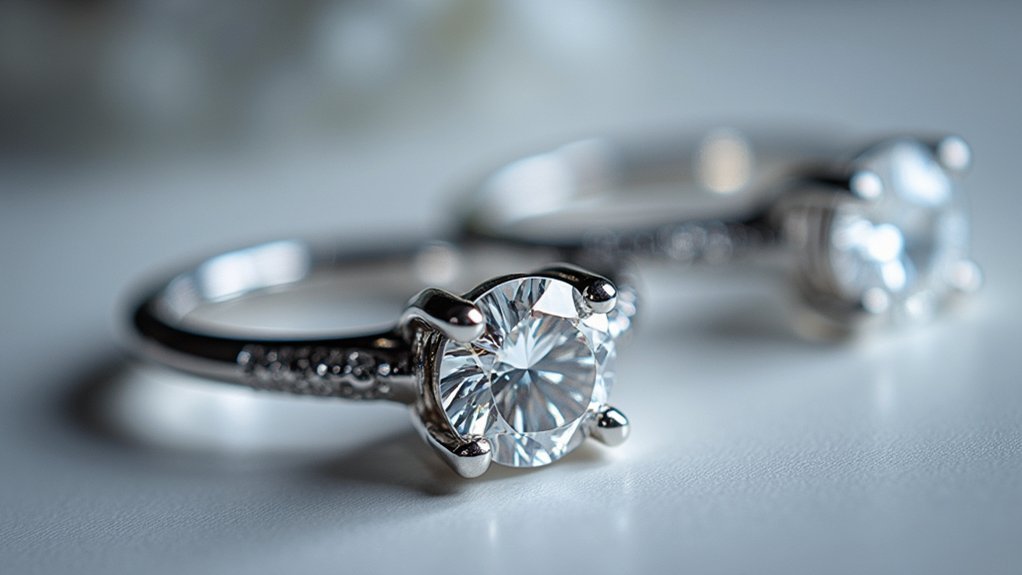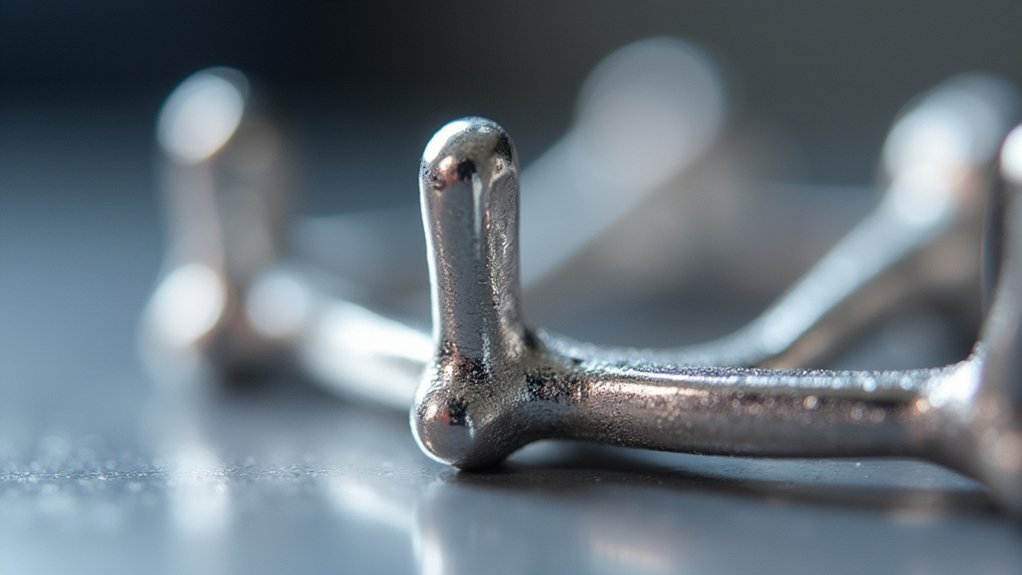You’ll maximize your gemstone security with platinum prongs that deliver 121,000 psi tensile strength, creating an unbreakable grip that won’t loosen over time. Unlike gold, platinum doesn’t lose metal when scratched and actually strengthens through work hardening during daily wear. Choose four-prong settings for maximum light entry or six-prong configurations for larger stones, while strategic compass positioning guarantees even weight distribution. The insights below reveal how this superior metal transforms your jewelry investment.
Understanding Platinum’s Superior Tensile Strength Properties

Strength defines platinum’s reputation in fine jewelry, particularly when it comes to securing precious gemstones. You’ll find platinum’s tensile strength reaches approximately 121,000 psi, making it exceptionally reliable for prong settings. This superior strength guarantees your prongs maintain their grip on diamonds and stones during daily wear, providing unmatched protection against loss or damage.
Unlike other metals, platinum doesn’t exhibit metal memory, so your prongs won’t loosen over time.
Platinum’s absence of metal memory ensures your prong settings maintain their secure grip on gemstones permanently without loosening.
You’ll appreciate platinum’s remarkable ductility, which allows jewelers to craft intricate prong designs without compromising structural integrity. This combination of tensile strength and workability means your platinum settings can secure gemstones beautifully while withstanding the stresses of everyday activities.
The durability platinum offers translates directly into long-lasting security for your precious stones.
How Platinum Prongs Secure Gemstones Better Than Gold
When comparing platinum to gold prongs, you’ll discover significant differences in gemstone security and longevity.
Platinum’s superior tensile strength creates a stronger grip on your diamond, dramatically reducing the risk of stones becoming loose or lost. Unlike gold, platinum doesn’t have “metal memory,” meaning your prongs maintain their original shape and position over time.
You’ll benefit from platinum’s unique property of retaining its mass when scratched, while gold loses small metal bits. This durability translates to better long-term protection for your gemstones.
Platinum’s malleability allows jewelers to craft prongs that snugly secure various stone shapes without compromising stability.
Most importantly, you’ll require less frequent maintenance with platinum prongs, saving both time and repair costs compared to gold settings.
The Science Behind Platinum’s Work Hardening Benefits

Although most metals weaken under stress, platinum defies this conventional behavior through a remarkable phenomenon called work hardening. When you handle platinum prongs repeatedly, they actually become stronger rather than deteriorating. This unique property increases the metal’s tensile strength through molecular restructuring, creating tighter atomic bonds that enhance durability.
You’ll appreciate how platinum’s malleability and ductility enable jewelers to craft intricate prong designs that benefit from this strengthening process. Unlike other metals with “memory” that revert to original shapes, platinum maintains its hardened form permanently.
This means your gemstones remain securely held without risk of diamond loss. The superior wear resistance platinum prongs develop through work hardening guarantees long-lasting performance that actually improves over time.
Comparing Prong Durability: Platinum Vs Other Precious Metals
While platinum’s work hardening properties set it apart from conventional metals, you’ll find its superiority becomes even more apparent when comparing prong durability across different precious metals. When evaluating precious metals for diamond security, platinum prongs demonstrate superior tensile strength and exceptional wear resistance compared to alternatives.
| Property | Platinum | Gold | Silver |
|---|---|---|---|
| Metal Memory | None | High | Medium |
| Maintenance Costs | Low | High | Very High |
| Hypoallergenic Nature | Complete | Variable | Good |
Unlike gold engagement rings that require frequent replating, platinum’s lack of metal memory guarantees consistent prong durability. You won’t experience the gradual loosening common with other metals. This translates to reduced maintenance costs and enhanced long-term diamond security, making platinum the superior choice for protecting your investment.
Optimal Prong Configurations for Maximum Stone Security

You’ll need to choose between four or six prongs to maximize your stone’s security, with six prongs offering superior grip for larger gemstones.
Strategic compass positioning guarantees even weight distribution across all contact points, preventing stress concentration that could loosen your setting over time.
Adding support bars between prongs creates a reinforced framework that dramatically increases structural stability while maintaining the elegant appearance of your platinum setting.
Four Vs Six Prongs
Two primary prong configurations dominate the world of platinum settings, each offering distinct advantages for securing your precious stones.
Four-prong settings deliver classic elegance while maximizing light entry to enhance your diamond’s brilliance. You’ll find these configurations provide excellent security without overwhelming your diamond engagement ring’s overall aesthetic.
Six-prong settings offer superior protection against damage, especially for larger or fragile gemstones. If a prong breaks, you’ll still have five remaining to secure your stone. The additional prongs create more intricate visual appeal while providing enhanced security for gemstones.
Both configurations benefit from platinum prongs’ superior tensile strength and durability. Through customization, you can optimize either design to match your preferences while maintaining maximum protection.
Compass Prong Positioning
Beyond choosing between four and six prongs, the strategic placement of these securing elements determines your stone’s ultimate protection and visual impact. Compass prong positioning places platinum prongs at 12, 3, 6, and 9 o’clock positions around your center stone, creating ideal stability through superior tensile strength.
| Position | Security Benefit |
|---|---|
| 12 & 6 O’Clock | Vertical weight distribution |
| 3 & 9 O’Clock | Horizontal pressure balance |
| Four-Point System | Maximum light exposure |
| Even Spacing | Reduced chipping risk |
| Strategic Placement | Enhanced durability |
This configuration evenly distributes weight and pressure across your gemstone while maximizing brilliance. Platinum’s exceptional tensile strength guarantees your prongs won’t bend or break under stress. The compass positioning provides robust stone security without compromising sparkle. Schedule regular inspections to maintain proper prong alignment and tightness for lasting protection.
Support Bar Integration
Support bars revolutionize prong settings by creating a unified framework that distributes stress across multiple contact points rather than isolating pressure on individual prongs.
You’ll find that platinum’s superior durability makes it ideal for these structural stability enhancements. When you integrate support bars into your prong configuration, you’re ensuring optimal weight distribution that prevents individual prongs from bending under pressure.
These integrated support bars keep your gemstone securely in place while maintaining the stone’s brilliance.
You can incorporate pierced patterns that strengthen the overall structure without sacrificing visual appeal. The strategic placement of support bars protects vulnerable stone corners while allowing light to enter from multiple angles, maximizing your gem’s sparkle and fire.
Long-Term Cost Benefits of Platinum Crown Settings

Investment in platinum crown settings delivers substantial financial advantages that extend far beyond the initial purchase price.
You’ll experience long-term cost benefits through dramatically reduced maintenance expenses, as platinum’s superior tensile strength requires 2.5 times fewer repairs than gold alternatives over ten years.
The metal’s exceptional durability provides superior gemstone protection, preventing costly stone loss or damage. Unlike other metals, platinum doesn’t suffer from “metal memory,” ensuring prongs maintain their grip without frequent adjustments.
You’ll save considerably since platinum’s natural white color eliminates expensive replating costs that white gold requires. The reduced repairs and minimal maintenance make this investment particularly cost-effective.
Your platinum crown settings will maintain their structural integrity and appearance for decades, proving this initial investment pays dividends through substantial long-term savings.
Maintenance Requirements for Platinum Prong Settings
While platinum’s durability translates to fewer repair costs, you’ll still need to follow specific maintenance practices to maximize your investment’s longevity.
Platinum prongs with superior tensile strength require minimal maintenance requirements compared to other metals. You should schedule regular examinations to verify your prongs are securely holding the diamond. Unlike gold, platinum doesn’t lose metal when scratched, making it less prone to wear over time.
Platinum’s exceptional tensile strength and metal retention properties make it the superior choice for secure, low-maintenance diamond prong settings.
Professional cleaning removes dirt and oil buildup while restoring luster. Due to platinum’s lack of metal memory, your prongs won’t bend easily, reducing frequent adjustments.
To maintain the integrity of prongs, you must avoid harsh chemicals and store your ring safely when unworn. These simple practices preserve platinum’s exceptional holding power.
Frequently Asked Questions
Are Platinum Prongs Strong?
Yes, you’ll find platinum prongs exceptionally strong due to their superior tensile strength. They won’t lose metal when scratched, they work harden with handling, and they’re denser than gold, ensuring your gemstones stay secure.
Can Platinum Prongs Break?
You’ll find platinum prongs can break under extreme force or impact, but they’re much less likely to break than other metals due to platinum’s superior tensile strength and durability.
What Is the Disadvantage of Platinum?
You’ll face higher upfront costs with platinum, typically $500-800 more than gold. It’s heavier, scratches easily requiring professional maintenance, and develops a patina that you might not prefer over polished finishes.
Will Platinum Prongs Bend?
You’ll find platinum prongs rarely bend due to their exceptional tensile strength. They’re considerably more resistant to bending than gold prongs, maintaining their shape and securely holding your gemstones even with regular wear.
In Summary
You’ll find that platinum prongs offer unmatched security for your precious gemstones through their superior tensile strength and work-hardening properties. While you’re investing more upfront, you’re getting exceptional durability that outperforms gold and other metals. Your stones stay secure longer, and you’ll spend less on repairs over time. With proper maintenance, you’re fundamentally future-proofing your jewelry investment. Choose platinum prongs when you want the ultimate protection for your valuable gems.





Leave a Reply